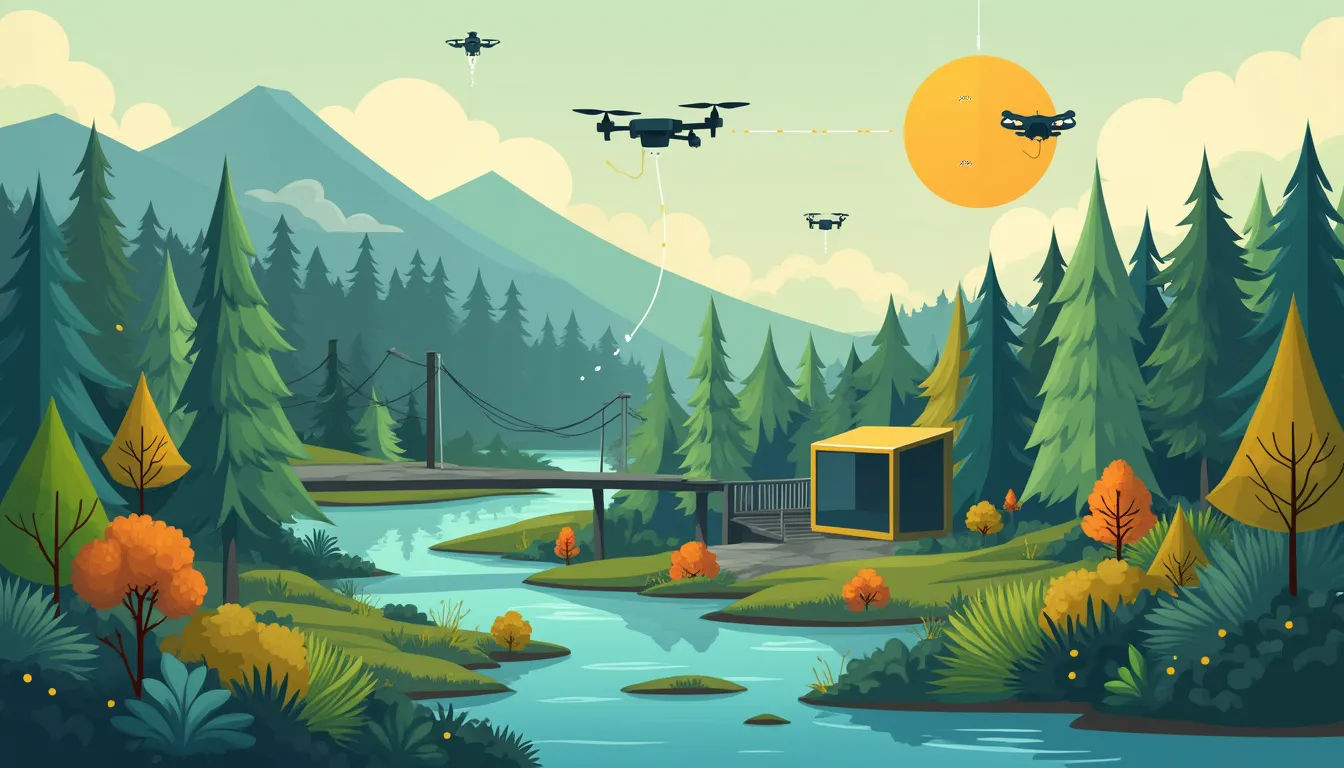In a world increasingly defined by the pressing need to safeguard our natural environment, the role of artificial intelligence (AI) in promoting environmental sustainability has never been more critical. Environmental sustainability, fundamentally, is about meeting our present needs without compromising the ability of future generations to meet theirs. This principle has gained unprecedented urgency as we tackle climate change, biodiversity loss, and resource depletion. Enter AI, a pivotal force capable of revolutionizing how we approach and implement sustainable practices across various industries. AI applications in environmental sustainability can optimize resources, predict environmental changes, and create innovative solutions for long-standing problems. The financial, agricultural, energy, and urban planning sectors are already reaping the benefits of AI-driven approaches to enhance their environmental responsibility and operational efficiency. Understanding the potential of AI in this arena is essential for businesses, policymakers, and individuals committed to fostering a sustainable future, while also navigating the nuanced challenges and opportunities it brings. Through real-world cases, prospective innovations, and a critical look at the ethical dimensions, this article aims to shed light on how AI applications are not only compatible with but essential for achieving environmental sustainability.
Introduction to AI Applications in Environmental Sustainability
Environmental sustainability isn’t just a buzzword thrown around to make companies look good on paper. It represents a critical pivot in how we interact with our planet, ensuring that the resources we consume today don’t compromise the ability of future generations to meet their needs. As global challenges like climate change, resource depletion, and pollution intensify, there’s an urgent need for innovative solutions—and that’s where AI applications in environmental sustainability come into play.
So, how exactly does Artificial Intelligence (AI) tie into this grand scheme of preserving our environment? At its core, AI refers to systems or machines that mimic human intelligence processes, learning from data and experiences to perform tasks and solve problems. From predicting climate patterns to optimizing energy use, AI is driving forward sustainable practices by offering real-time insights, efficiency, and unprecedented problem-solving abilities. By leveraging AI, we can enhance our understanding of complex environmental systems and develop more effective strategies to protect them.
Significance of AI in Driving Sustainable Practices
AI’s significance in driving sustainable practices cannot be overstated. One of its most profound impacts lies in data processing. The environment operates as a vast, interconnected set of systems influenced by countless variables, such as weather patterns, human activities, and natural events. Traditional methods of analyzing these systems often fall short due to the complexity and volume of data involved. AI steps in here, handling massive datasets with ease, identifying trends and predicting future scenarios with high accuracy.
Consider the challenges of climate change prediction. Accurately predicting future climate patterns is crucial for developing strategies to mitigate its effects. AI models are capable of processing vast amounts of climatic data and learning from previous weather patterns to make precise predictions. Additionally, they can simulate outcomes of various environmental interventions, helping policymakers choose the most effective courses of action. It’s like having a crystal ball, but one that’s backed by science and data.
Next, AI can substantially reduce waste and enhance resource efficiency across various industries. From smart agriculture techniques that optimize water and fertilizer use to AI-driven industrial processes that minimize material waste, the applications are varied and impactful. For instance, AI algorithms can monitor crop health in real-time, suggesting the exact amount of water or nutrients needed, thereby conserving resources and boosting yield. This not only helps in achieving food security but also ensures that farming practices are sustainable in the long run.
Industries Leveraging AI for Environmental Benefits
Several industries are already reaping the benefits of AI in their quest for environmental sustainability. In the energy sector, AI technologies are optimizing the operation of renewable energy sources, such as wind and solar power. By predicting energy production based on weather forecasts and adjusting grid operations accordingly, AI helps in balancing supply and demand more efficiently. This reduces reliance on fossil fuels, thereby cutting greenhouse gas emissions.
The transportation industry also benefits immensely from AI. Through intelligent traffic management systems and autonomous vehicles, AI contributes to reducing traffic congestion and emissions. Smart logistics solutions powered by AI can optimize delivery routes, conserving fuel and lowering carbon footprints. Moreover, public transportation systems enhanced by AI can provide real-time updates, improving efficiency and encouraging more people to use greener transit options.
Manufacturing is another domain where AI plays a pivotal role. On factory floors, AI-driven robots and machines streamline production processes, reducing waste and energy consumption. Predictive maintenance algorithms anticipate equipment failures, minimizing downtime and the need for replacements. This not only ensures smoother operations but also fosters a circular economy where resources are reused and recycled, rather than discarded.
Lastly, we must mention the utilities and water management sectors. AI-powered systems can detect leakages in water supply networks and monitor water quality in real-time, ensuring that precious water resources are conserved and properly managed. Additionally, AI can optimize electricity usage patterns, shaving off peak loads and encouraging more sustainable consumption behaviors.
As someone who’s navigated the complexities of safety protocols and AI applications while juggling personal challenges like ADHD, OCD, and weight loss, I can attest to the transformative power of technology. AI doesn’t just offer solutions; it provides a framework for innovating beyond the constraints of traditional methods. It’s like how my meticulous nature, driven partly by OCD, ensures precision in monitoring AI systems, and my hyper-focus, a feature of ADHD, allows me to delve deeply into complex AI problems tirelessly. In the same way, AI leverages its capabilities to tackle environmental issues with relentless precision and adaptability.
In future segments, we will delve deeper into specific AI applications that are making waves in environmental sustainability. From intelligent climate solutions and smart agriculture to pollution control and renewable energy optimization, AI is a powerful ally in the fight for a sustainable future. So, stay tuned for insights and real-world examples that underline the pivotal role of AI in saving our planet.

Key AI Applications in Environmental Sustainability
AI in Climate Change Prediction and Mitigation
AI applications in environmental sustainability are revolutionizing the way we predict and mitigate climate change. Advanced machine learning algorithms can analyze vast amounts of data from climate models, satellite imagery, and historical weather patterns to make highly accurate predictions. For instance, Google’s AI subsidiary, DeepMind, has developed models that can predict wind patterns up to 36 hours in advance. These predictions help energy companies optimize wind turbine operations, resulting in a 20% reduction in energy wastage.
Another compelling example is the AI-driven efforts by the Climate Change AI community, which uses neural networks to interpret climate data. Their work has enabled more precise predictions of extreme weather events, ensuring better preparedness and response strategies. These applications illustrate how AI not only enhances our understanding of climate dynamics but also plays a critical role in formulating effective mitigation policies.
Smart Agriculture and Farming Techniques Enhanced by AI
In the realm of agriculture, AI applications are paving the way for smarter, more sustainable farming practices. Precision agriculture is a prime example where AI-driven technologies, such as drones and sensors, provide real-time data on crop health, soil conditions, and weather forecasts. Such data enables farmers to make informed decisions on irrigation, fertilization, and pest control, ultimately improving crop yields and reducing environmental impact.
Consider the case of John Deere’s AI-powered tractors, which use computer vision to identify and differentiate between crops and weeds. This innovation allows for targeted herbicide applications, significantly reducing chemical usage and promoting soil health. Similarly, AI algorithms developed by Blue River Technology facilitate crop scouting, giving farmers immediate insights into their fields’ needs and contributing to more sustainable agricultural practices.
AI-Driven Solutions for Reducing Pollution and Waste Management
Pollution and waste management are critical challenges where AI applications in environmental sustainability are making substantial impacts. AI algorithms can analyze waste production patterns and optimize recycling processes. For instance, the startup, AMP Robotics, uses AI-driven robots to sort through recyclable materials with an accuracy rate surpassing traditional methods. This technology has the potential to significantly reduce landfill waste and improve recycling efficiency.
AI is also being used to monitor air quality and identify pollution sources. Environmental monitoring systems such as Microsoft’s AI for Earth utilize machine learning to analyze satellite imagery and detect changes in air quality levels. By pinpointing pollution hotspots, governments and organizations can implement targeted interventions to mitigate environmental damage. These AI solutions are crucial in helping us transition towards a more sustainable and cleaner future.
Renewable Energy Optimization Through AI Technologies
Renewable energy sources are a cornerstone of environmental sustainability, and AI applications are instrumental in optimizing these resources. Machine learning algorithms are used to forecast energy supply and demand accurately, integrate renewable energy sources into the grid, and improve storage solutions. This is particularly evident in solar and wind energy sectors.
For example, Siemens employs AI to enhance the performance and lifespan of wind turbines. Their AI systems predict maintenance needs and optimize resource allocation, resulting in higher efficiency and lower operational costs. Similarly, Google’s DeepMind has applied AI to control the cooling of data centers, reducing energy consumption by nearly 40%. This significant reduction showcases the vast potential of AI in driving energy efficiency and sustainability.
Moreover, AI applications facilitate the development of smart grids, which can dynamically respond to energy demands and supply fluctuations. By optimizing energy distribution, we can minimize waste and maximize the use of renewable resources. These advancements underscore the importance of AI in achieving a sustainable and energy-efficient future.

Case Studies of AI Applications in Environmental Sustainability
Successful Implementation of AI in Tracking and Reducing Carbon Footprint
AI applications in environmental sustainability have shown remarkable success, particularly in tracking and reducing carbon footprints. For instance, consider the case of Carbon Lighthouse, a company that leverages AI to reduce building emissions. The company’s proprietary AI platform, called CLUES, analyzes thousands of data points from building sensors to identify inefficiencies. One real-world example involved a major commercial office building in New York City. Through AI-driven insights, Carbon Lighthouse identified opportunities for reducing energy consumption by tweaking HVAC system operations and optimizing lighting usage. As a result, the building saw a reduction of its carbon footprint by 20%, demonstrating AI’s pivotal role in environmental sustainability.
Real-World Examples of AI in Conservation Efforts and Biodiversity Monitoring
AI’s promise isn’t confined to urban environments; it also plays a crucial role in conservation and biodiversity monitoring. Take the Wildlife Insights platform as an example. This innovative project utilizes AI to analyze millions of photos captured by motion-sensitive cameras placed in various ecosystems. The AI algorithms can identify species, count individuals, and determine patterns in wildlife movement much faster than human researchers ever could. This accelerated data processing aids in more effective implementation of conservation measures.
A noteworthy story comes from a project in the Brazilian Amazon, where AI technology has been employed to monitor jaguar populations. By accurately identifying and cataloging individual jaguars, conservationists can track their movements and health, making it easier to protect this endangered species. The AI-driven insights have already resulted in improved habitat management policies, showcasing how AI applications in environmental sustainability are directly contributing to biodiversity conservation.
Notable Projects and Initiatives Using AI for Sustainable Urban Planning
Urban planning is another domain where AI’s impact is profoundly felt. The Singaporean government’s Smart Nation initiative is a stellar example of how AI applications in environmental sustainability are shaping the cities of the future. Leveraging AI for urban development, the initiative focuses on various aspects including efficient waste management, smart transportation, and sustainable housing solutions.
One of the most impressive AI-driven projects under this initiative is the Virtual Singapore platform. It’s a dynamic 3D digital replica of the city that integrates real-time data and predictive models. Urban planners use this platform to simulate different environmental scenarios, such as the impact of new buildings on natural sunlight distribution and wind flow. By doing so, they can make data-driven decisions that foster sustainable urban growth. Additionally, AI algorithms evaluate traffic patterns to devise efficient public transportation systems, further minimizing environmental impacts.
AI Contributions to Efficient Natural Resource Management
Natural resource management is another critical area benefiting from AI technologies. IBM’s Green Horizons project stands out as a pioneering initiative demonstrating this potential. Employing AI and advanced data analytics, the project helps cities around the globe predict air pollution levels, manage water resources, and optimize energy consumption.
In China, Green Horizons has partnered with Beijing’s environmental protection bureau to overhaul the city’s air quality monitoring system. Utilizing AI, the project analyzes vast amounts of data from satellite images, weather forecasts, and traffic information to predict pollution spikes. As a result, targeted actions can be deployed much more effectively. For instance, when the system anticipates high pollution levels, authorities can restrict certain vehicle usages or halt factory operations proactively, rather than reactively.
Moreover, in agriculture-rich regions, AI-driven insights from precision farming techniques aid in optimizing water and fertilizer usage. Companies like John Deere have equipped their machinery with AI to analyze soil conditions, crop health, and weather patterns. This granular level of data allows farmers to make informed decisions, maximizing yields while minimizing resource use. Such applications not only help in conserving natural resources but also significantly reduce the environmental footprint of agricultural activities.
These case studies reflect the broad potential and diverse applications of AI in building a sustainable future. Whether it’s tracking carbon footprints, conserving biodiversity, planning urban spaces, or managing natural resources, AI serves as a powerful ally in the quest for environmental sustainability.
By examining these tangible examples, we gain valuable insights into the transformative potential of AI applications in environmental sustainability. As we forge ahead, the lessons learned from these initiatives can guide future efforts, ensuring that technological advancements align harmoniously with our environmental goals.

Future Prospects and Challenges in AI Applications for Environmental Sustainability
As we stand at the cusp of a technological revolution, the future prospects of AI applications in environmental sustainability are both exciting and laden with potential. Innovative AI-driven solutions are being continuously developed and refined to tackle the pressing environmental challenges we face today. This section will delve into the emerging trends, potential barriers, and the vital role of policy and cooperation in harnessing these technologies for a sustainable future.
Innovations on the Horizon in AI and Environmental Sustainability
Emerging innovations in AI are poised to significantly transform how we manage and protect our environment. Autonomous drones equipped with AI are being designed to monitor environmental changes and collect critical data in real-time. Such drones can navigate harsh terrains, gather information on deforestation, track wildlife populations, and even identify illegal logging activities. This not only enhances our ability to respond swiftly to environmental threats but also frees up human resources for more strategic tasks.
Another compelling development is the application of AI in enhancing renewable energy systems. Next-generation AI algorithms are being created to optimize energy storage and grid management. These systems can predict energy demand, dynamically adjust supply, and even integrate renewable energy sources like wind and solar into the grid more efficiently. Imagine a world where power outages are almost non-existent, and the energy you use is both clean and sustainable—this could soon be a reality, driven by AI innovation.
Potential Barriers and Ethical Considerations
While the prospects are undoubtedly promising, there are significant barriers to the widespread adoption of AI applications in environmental sustainability. One major challenge is the high cost associated with the initial deployment of AI technologies. From the development of sophisticated algorithms to the installation of advanced hardware, the financial investment required can be daunting, particularly for developing nations. Consequently, financial constraints could exacerbate existing global inequalities, limiting the benefits of AI to wealthier regions.
Alongside financial barriers, there are pressing ethical considerations. The deployment of AI must be carefully managed to ensure it does not inadvertently harm the ecosystems it aims to protect. For instance, the use of autonomous drones raises privacy concerns, as these devices can record images and data without consent. Ensuring robust data protection measures and transparent usage policies will be essential to maintain public trust and support for AI initiatives.
Moreover, there’s the critical aspect of algorithmic bias. AI systems are only as good as the data fed into them. Inaccurate or biased data can lead to flawed outcomes, potentially causing more harm than good. For example, an AI-driven system designed to optimize irrigation in agriculture might favor areas with already abundant resources, neglecting those in dire need. To mitigate this, continuous monitoring, updating, and fine-tuning of AI algorithms will be vital.
The Role of Policy and Global Cooperation in Advancing AI Solutions
As we navigate through the complexities of implementing AI in environmental sustainability, the role of policy and global cooperation cannot be overstated. Policymakers must craft legislation that encourages innovation while safeguarding against potential risks. This includes creating favorable regulations for AI startups, providing subsidies for sustainable tech initiatives, and setting stringent standards for data privacy and security.
International cooperation is equally crucial. Climate change and environmental degradation are global issues that transcend borders, and so should the solutions. Collaborative efforts, such as international research initiatives and cross-border data sharing agreements, can accelerate the development and deployment of AI technologies. Moreover, global platforms like the United Nations can play a pivotal role in facilitating these collaborative efforts, setting global standards, and providing a forum for sharing best practices.
Encouraging Public and Private Investments in AI Technologies for a Sustainable Future
Ultimately, the success of AI applications in environmental sustainability hinges on robust investment from both public and private sectors. Public funding is essential for foundational research and pilot projects that may not be immediately profitable but have long-term potential. Governments can also drive market demand through green public procurement policies, thereby fostering an ecosystem that values sustainability.
Private investment, on the other hand, brings agility and scale to the table. Venture capitalists and corporate investors can quickly propel innovative startups and research initiatives. For instance, tech giants like Google and Microsoft are already making significant strides in green AI technologies, such as AI models that optimize data center operations to reduce energy consumption. By aligning profit motives with sustainability goals, private investors can play a key role in scaling AI solutions.
In conclusion, the future of AI applications in environmental sustainability holds immense promise, provided we navigate the challenges thoughtfully. By fostering innovation, addressing ethical concerns, and building strong policy frameworks bolstered by global cooperation, we can unlock the full potential of AI to create a sustainable and prosperous future for all.
As we journey through an era marked by unprecedented environmental challenges, the integration of AI applications in environmental sustainability emerges not merely as an innovation but as an imperative. The tapestry woven through climate change prediction, smart agricultural advancements, pollution reduction, and renewable energy optimization showcases AI’s transformative potential. The case studies presented illuminate the tangible benefits of AI—from tracking carbon footprints and promoting biodiversity to enhancing urban planning and resource management. These examples provide a promising glimpse into a future where technology and nature harmonize.
Looking ahead, the horizon is aglow with potential breakthroughs. However, it is critical to navigate the path with a clear understanding of the hurdles that lie ahead. Ethical considerations, data privacy issues, and the potential for AI misapplications must be addressed to ensure that our technological pursuits do not compromise the very fabric of sustainability they seek to protect. Furthermore, robust policies and global cooperation are essential to foster an environment where AI can thrive and deliver on its promises.
In this context, the role of both public and private investments cannot be understated. Channeling capital into innovative AI technologies that prioritize sustainability can catalyze progress and drive widespread adoption. But perhaps the most essential ingredient in this endeavor is the collective will to prioritize our planet’s health.
As someone who has navigated personal challenges such as managing ADHD and OCD, I understand the power of determination and the impact of innovative solutions. Just as I’ve harnessed strategies to overcome these obstacles in my life and work, we, as a global community, must leverage AI’s capabilities to surmount environmental hurdles.
In closing, I invite you to be a part of this transformative journey. Whether you are a policy-maker, an investor, a technologist, or an everyday citizen, your actions matter. Advocate for sustainable practices, support AI-driven initiatives, and champion the intersection of technology and environmental stewardship. Together, we can harness the full power of AI to forge a more sustainable and resilient future for generations to come.
Support Us: Check out our recommended products on Amazon.

